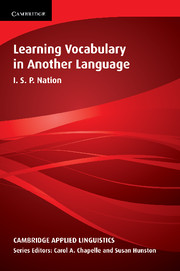Book contents
- Frontmatter
- Contents
- Series editors' preface
- Acknowledgements
- Introduction
- 1 The goals of vocabulary learning
- 2 Knowing a word
- 3 Teaching and explaining vocabulary
- 4 Vocabulary and listening and speaking
- 5 Vocabulary and reading and writing
- 6 Specialised uses of vocabulary
- 7 Vocabulary learning strategies and guessing from context
- 8 Word study strategies
- 9 Chunking and collocation
- 10 Testing vocabulary knowledge and use
- 11 Designing the vocabulary component of a language course Goals
- Appendixes
- References
- Subject index
- Author index
6 - Specialised uses of vocabulary
Published online by Cambridge University Press: 05 October 2012
- Frontmatter
- Contents
- Series editors' preface
- Acknowledgements
- Introduction
- 1 The goals of vocabulary learning
- 2 Knowing a word
- 3 Teaching and explaining vocabulary
- 4 Vocabulary and listening and speaking
- 5 Vocabulary and reading and writing
- 6 Specialised uses of vocabulary
- 7 Vocabulary learning strategies and guessing from context
- 8 Word study strategies
- 9 Chunking and collocation
- 10 Testing vocabulary knowledge and use
- 11 Designing the vocabulary component of a language course Goals
- Appendixes
- References
- Subject index
- Author index
Summary
When learners have mastered the 2,000–3,000 words of general usefulness in English, it is wise to direct vocabulary learning to more specialised areas. Depending on the aims of the learners, it is possible to specialise by learning the shared vocabulary of several fields of study, for example academic vocabulary. Subsequently, the specialised vocabulary of one particular field or part of that field can be studied. Because many courses focus on learners who will do academic study in English, we will look first at academic vocabulary.
Academic vocabulary
Academic vocabulary is variously known as ‘generally useful scientific vocabulary’ (Barber, 1962), ‘sub-technical vocabulary’ (Cowan, 1974; Yang, 1986; Anderson, 1980), ‘semi-technical vocabulary’ (Farrell, 1990), ‘specialised non-technical lexis’ (Cohen, Glasman, Rosenbaum-Cohen, Ferrara and Fine, 1988), ‘frame words’ (Higgins, 1966), and ‘academic vocabulary’ (Martin, 1976; Coxhead, 2000). The division of the vocabulary of academic texts into three levels – general service or basic vocabulary, sub-technical vocabulary and technical vocabulary – is commonly made (although this distinction ignores low-frequency vocabulary with no technical or sub-technical features). Dresher (1934) made such a three-part division when looking at mathematics vocabulary for native speakers. Other writers have independently made a similar distinction. Typically, academic vocabulary lists include words like accumulate, achieve, compound, complex and proportion which are common in academic texts and not so common elsewhere.
Flood and West (1950) posed the question ‘How many words are needed to explain everything in science to someone who has little or no training in science?’
- Type
- Chapter
- Information
- Learning Vocabulary in Another Language , pp. 187 - 216Publisher: Cambridge University PressPrint publication year: 2001
- 1
- Cited by

